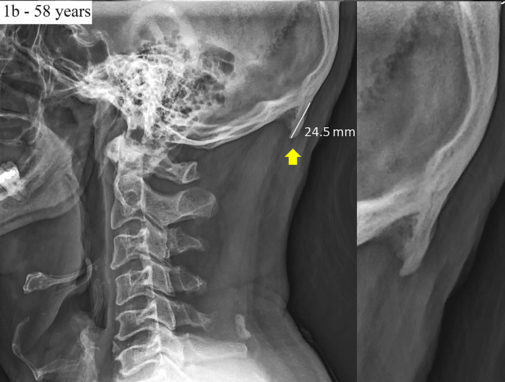Technology seriously damages health. It is recognized by the Silicon Valley gurus themselves, who raise their children in schools without a Wi-Fi signal. And doctors also warn: mobile phones and tablets can lead to significant physical injuries. To the list of possible sequels related to the intensive use of screens (such as loss of vision, known contractures or injuries caused by selfie negligence) we must now add the appearance of a strange bone in the upper part of the neck. This phenomenon has just been discovered and typified by a team of researchers from the University of Sunshine Coast in Australia, led by doctor and chiropractor David Shahar. "I began to investigate after detecting in my patients exceptionally large osteophytes that develop in the area where the trapezius muscle tendon adheres to the occipital bone in the upper part of the skull," Shahar tells Chronicle . "What struck me most was the prevalence and magnitude of these pathological bone projections in adolescents and young adults."
A few weeks ago the BBC and the Washington Post echoed Shahar's conclusions, which were published by the Journal of Anatomy and Scientific Reports. According to the study, the persistence in anomalous postures derived from the use of technological devices could be related to the presence of an external occipital protuberance (EOP).
Until now these bends, frequent in elderly people, were due to natural degenerative processes of the muscles and skeleton. But, of the 218 cervical radiographs that the Shahar team performed on young people between 18 and 30, 41% had developed a bone lump of between 10 and 30 millimeters. "It was a most surprising discovery if we consider that osteophytes take years to develop and usually measure a few millimeters."
The results of the study provide new evidence on what until now was known as Text Neck Syndrome, according to which some smartphone users would be supporting a cervical pressure of up to 30 kilos. "The displacement of the head generates a muscular load that shifts the weight of the bones of the spine to the muscles of the back of the neck," explains the chiropractor. «Through an adaptation process, the bone widens to distribute stress over a larger surface. Gradually, the bone matrix invades the tendons until it results in a more robust union, that is, a bone spur ».
The "horn of technological abundance" hypothesis spread like wildfire through internet forums and Shahar soon became a target of attacks by the scientific community. "Most of the criticism comes from people who have not bothered to read our research," he defends. "We have never established a direct link between the presence of osteophytes and the use of mobile technology, but we have merely suggested that the cause seems to be mechanical."
A few days ago the New York Times questioned his hypothesis with a truffled article by expert statements in neurosurgery and rehabilitation. "Our research is cross-sectional, not a randomized clinical trial (RCT), whose process would take about 15 years and would require fairly invasive techniques," he says.
CERVICAL INJURIES
Cervical lesions are not a modern invention. In the 70s, Americans spent an average of two hours a day with their heads tilted toward books, half the time they spend today on mobile phones. "Skeleton formation is a highly dynamic and ongoing physiological process," says Shahar. "Although its development is mainly driven by genetic factors, its structural remodeling responds to a great extent to how we use it during our lives." And he gives as an example the loss of bone density of astronauts after a long period safe from the effects of gravity. "In fact, there is a discipline called osteobiography that studies these structures to decipher the lifestyle of a community at a certain historical moment."
Like the horns at the base of the skull, other alterations in the shape of our bones are being detected. Christiane Scheffler, a prestigious anthropologist at the University of Potsdam, has recently discovered that our elbows are shrinking. «Our bones are surprisingly malleable. Now, most likely, the osteophytes do not disappear and continue to grow as stalactites, ” warns the chiropractor. "What's more, some bone projections already exceed 3 centimeters."
In light of the results published by the Journal of Anatomy and Scientific Reports, the prevalence of external occipital protuberance affects 33% of the population, with a higher incidence in men (67%). The longest osteophyte detected in a male reached 3.6 centimeters, compared to 2.7 registered by one of the volunteers during the tests. To detect it, simply press with your fingers on the upper part of the neck. "If they feel a lump, it is best to put themselves in the hands of a specialist," Shahar recommends. «You can recalibrate the body posture with special pillows, exercise tables and, of course, new habits related to the responsible use of technological devices».
According to the criteria of The Trust Project
Know more
